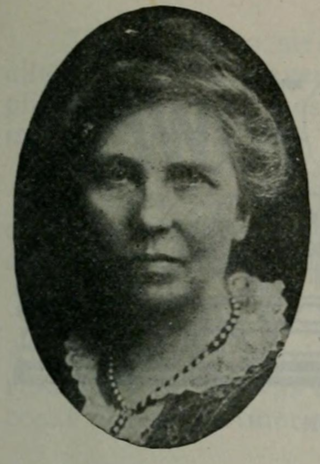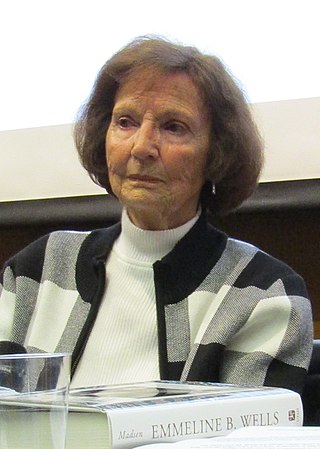
The Woman's Exponent was a semi-official publication of the Church of Jesus Christ of Latter-day Saints that began in 1872. It published articles advocating for women's suffrage and plural marriage, in addition to poetry and other writings. Lula Greene Richards and Emmeline B. Wells were its editors until 1914, when the Exponent was dissolved. It was "the first long-lived feminist periodical in the western United States." While it had no direct successor, the Relief Society did launch its own magazine, the Relief Society Magazine, in 1915.

Martha Maria "Mattie" Hughes Cannon was a Utah State Senator, physician, Utah women's rights advocate, suffragist, polygamous wife, and a Welsh-born immigrant to the United States. Her family immigrated to the United States as converts to the Church of Jesus Christ of Latter-day Saints and traveled West to settle in Utah territory with other Saints. She started working at the age of fourteen. At sixteen she enrolled in the University of Deseret, now called the University of Utah, receiving a Bachelors in Chemistry. From there she attended the University of Michigan and received her MD. She became the fourth of six wives in a polygamous marriage to Angus M. Cannon, a prominent Latter-day Saint leader during the anti-polygamy crusade. Cannon exiled herself to Europe so she wouldn't have to testify against her husband and others. Upon returning to Utah, Cannon worked as a doctor and fought for women's rights. She helped put women enfranchisement into Utah's constitution when it was granted statehood in 1896. On November 3, 1896 Cannon became the first female State Senator elected in the United States, defeating her own husband, who was also on the ballot. Martha Hughes Cannon was the author of Utah sanitation laws and was a founder and member of Utah's first State Board of Health.

Emmeline Blanche Woodward Harris Whitney Wells was an American journalist, editor, poet, women's rights advocate, and diarist. She served as the fifth Relief Society General President of the Church of Jesus Christ of Latter-day Saints from 1910 until her death. She represented the state of Utah at both the National and American Women's Suffrage conventions and was president of the Utah Woman's Suffrage Association. She was the editor of the Woman's Exponent for 37 years. She was a plural wife to Newel K. Whitney, then Daniel H. Wells.

Elizabeth Wells Cannon, also referred to as Annie Wells Cannon, was a prominent women's suffragist in Utah who served in the Utah House of Representatives from 1913 to 1915 and again in 1921. She was also president of the Daughters of Utah Pioneers and a charter member of the Utah Red Cross.

Heber Manning Wells was an American politician and banker who served as the first governor of the State of Utah. Utah gained statehood on January 4, 1896; Wells served as governor from January 6, 1896, until January 2, 1905.

John Thomas Caine was a delegate to the United States House of Representatives from the Territory of Utah.

Joseph Spencer Cornwall was a conductor of the Mormon Tabernacle Choir in the mid-20th century.

LaVern Watts Parmley was the fifth general president of the Primary of the Church of Jesus Christ of Latter-day Saints. Parmley was the first woman to be awarded the Silver Buffalo Award from the Boy Scouts of America.

Margaret Young Taylor was a member of the inaugural general presidency of the Young Ladies' National Mutual Improvement Association, now the Young Women organization of the Church of Jesus Christ of Latter-day Saints from 1880 to 1887. She was one of the plural wives of John Taylor, a president of the LDS Church.

Sarah Melissa Granger Kimball was a 19th-century Latter-day Saint advocate for women's rights and early leader in the Relief Society of the Church of Jesus Christ of Latter-day Saints. Kimball's involvement in the church led to the establishment of the women's Relief Society as well as participation in the national suffrage movement.

Emma Lucy Ann Gates Bowen was an American opera singer and later the wife of Albert E. Bowen, a member of the Quorum of the Twelve Apostles of the Church of Jesus Christ of Latter-day Saints. She was often referred to as Lucy Gates and after her marriage as Lucy Gates Bowen or Lucy Bowen.

Carol Cornwall Madsen is an emeritus professor of history at Brigham Young University (BYU) where she was a research historian with the Joseph Fielding Smith Institute for Church History. She also served as associate director of BYU's Women's Research Institute. She has written 50 scholarly articles and several books.

Women's suffrage in Utah was first granted in 1870, in the pre-federal period, decades before statehood. Among all U.S. states, only Wyoming granted suffrage to women earlier than Utah. Because Utah held two elections before Wyoming, Utah women were the first women to cast ballots in the United States after the start of the suffrage movement. However, in 1887 the Edmunds–Tucker Act was passed by Congress in an effort to curtail Mormon influence in the territorial government, disallowing the enfranchisement of the women residents within Utah Territory. Women regained the vote upon Utah statehood in 1896, when lawmakers included the right in the state constitution.
Sarah Marietta Kingsley Cleveland was the first counselor to Emma Smith in the presidency of the Relief Society from 1842 to 1844.

Emily Sophia Tanner Richards was a key figure in the founding of the Utah Woman's Suffrage Association.
Mormon feminism is a feminist religious social movement concerned with the role of women within Mormonism. Mormon feminists commonly advocate for a more significant recognition of Heavenly Mother, the ordination of women, gender equality, and social justice grounded in Mormon theology and history. Mormon feminism advocates for more representation and presence of women as well as more leadership roles for women within the hierarchical structure of the church. It also promotes fostering healthy cultural attitudes concerning women and girls.

Charlotte Ives Cobb Kirby was an influential and radical women's rights activist and temperance advocate in the state of Utah as well as a well-known national figure. Charlotte was born in Massachusetts and at seven years of age moved to Nauvoo, Illinois with her mother, an early member of the Church of Jesus Christ of Latter-day Saints. There, without divorcing father Henry Cobb, her mother became Brigham Young's second plural wife. They then moved to Utah in 1848. Charlotte, previously a plural wife herself, spoke out against polygamy and gained much opposition from polygamous women suffragists because of it. Her first marriage was to William S. Godbe, the leader of the Godbeite offshoot from the LDS Church. After divorcing Godbe, Kirby married John Kirby, a non-LDS man, and they were together until Charlotte's death in 1908. Charlotte was a leading figure of the Utah Territory Woman Suffrage Association, and served as a correspondent to the government and other suffragist organizations, including the National Women's Suffrage Association. Charlotte often traveled to the East Coast to deliver lectures regarding women's rights and temperance, the first Utah woman and the first woman with voting rights to speak to national suffragist audiences. Charlotte Ives Cobb Kirby died on January 24, 1908, at age 71 in Salt Lake City, Utah.

Leonora Cannon Taylor was born in the Isle of Man into a large family. After the death of her father, she moved to London where she joined the Methodist church. Later while living in Canada, she joined the Church of Jesus Christ of Latter-day Saints. In the church, Taylor was a member of the Relief Society organization at the time of its origin and the first wife of John Taylor, the third president of The Church of Jesus Christ of Latter-day Saints. Taylor and her husband had eight children together. With her family, Taylor traveled across the United States to settle in Utah.
Since the beginning of political activity in Utah, Women were highly involved in their local political system. This is evident in the very fact that the Utah Constitution granted women the right to vote—20 years before the 19th Amendment was passed nationally. Despite high levels of female participation in politics and government, the issue of women's suffrage saw both support by Utah women and opposition by many other Utah women.
Antoinette Brown Kinney (1862–1945) was an American politician and community leader who served in the Utah State Senate.















